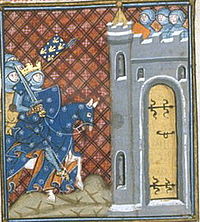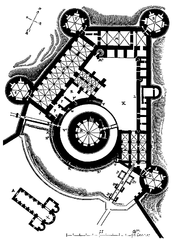Coucy Castle
| Coucy Castle | ||
|---|---|---|
|
Ring wall and flanking towers of the outer bailey |
||
| Castle type : | Hilltop castle | |
| Conservation status: | ruin | |
| Standing position : | Feudal castle | |
| Place: | Coucy-le-Château refresh | |
| Geographical location | 49 ° 31 '18 " N , 3 ° 19' 7" E | |
|
|
||
The Coucy Castle ( French Château de Coucy ) in Coucy-le-Château-Auffrique is the ruin of one of the most important medieval feudal castles in Europe. Coucy castle and town are located in the Aisne ( Picardy ) department between Laon and Soissons . The enormous hill fort was badly damaged by German troops during the First World War in 1917 when the huge round donjon was blown up , which up to that date was the highest donjon in France with a height of 54 meters.
history
The origins of today's castle complex go back to the early 10th century, when the Arch Chancellor and Archbishop of Reims Herive had the first small fortification built to protect his fiefdom around 920 . In 1066 Enguerrand I. de Boves was enfeoffed with Coucy Castle, which began with the expansion of the fortress in 1079. The family then named themselves after their new fiefdom . The rich and powerful barons of Coucy quickly linked themselves to the great noble families of Europe through numerous weddings .
Enguerrand III. In 1226 even raised claims to the French royal throne. Enguerrand's arrogance could, however , be thwarted by the prudence of the later regent Blanka of Castile .
As a status symbol and symbol of power, Enguerrand III. In one act of the colossal expansion of the entire complex from 1220 in almost 20 years with the city wall (the extraordinarily massive design of the Port de Laon and 35 towers) and main castle, in particular the most elaborate donjon of the French Middle Ages. This colossal keep exceeded the dimensions of the main towers of the royal complex of the high medieval Louvre by far. 800 stonemasons are said to have been employed at the same time on the construction site .

The castle was besieged in vain by English troops in 1339, by Enguerrand VII , a Habsburg on his mother's side , modernized and expanded, and after the barons died out in 1400, it fell back to the crown.
In the following centuries the fortress changed hands several times, was besieged, rebuilt and expanded. 1652 the troops of Cardinal blew Mazarin the vaults of the keep and devastated the castle. The lord of the castle had refused to hand over his inherited feudal rights to the absolutist king .
Subsequently, the complex shared the fate of so many castles: it was misused as a quarry and prison , and it was used as a retirement home. The 19th century finally recognized the high architectural and historical value of this major work of medieval defense architecture. The well-known architect and art historian Eugène Viollet-le-Duc began in 1856 with the restoration and partial completion of the donjon and the outer works.
During the First World War, the castle - although it had been occupied by German troops since 1914 - fatally came close to the front line in 1917. The German army command decided, despite numerous protests from German and foreign historians and even the Bavarian Crown Prince Rupprecht as part of the company's Alberich blowing up the Donjon. On March 27, 1917, 28 tons of dynamite were distributed in the tower and detonated. Before that, however, an exact construction survey and documentation was made by well-known experts.
The well-known architect and castle researcher Bodo Ebhardt visited the complex as early as 1915 during a tour through the war zones of Belgium and northern France on behalf of Kaiser Wilhelm II . Ebhardt worked in the castle for about ten days and made numerous drawings and plans of the holdings. From the nationalistic point of view that is typical for him , Ebhardt interpreted the Coucy castle as an " example of the real knightly, Germanic development of strength of the Franconian gentry who then ruled the low-ranking Gallic masses ". During his stay, the emperor and the crown prince also surprisingly attended the festivities.
The demolition masters worked so thoroughly that today only a large pile of rubble shows the location of the monumental building. The other parts of the inner castle were also badly damaged, especially the outer ring wall with its flanking towers . Each of these outer towers originally had the dimensions of a "normal" donjon. Contemporary aerial photographs indicate that these components were also deliberately blown up.
After the Second World War , the remains of the castle were secured and partially supplemented and can be viewed today. Some idealists are even planning the reconstruction of the huge tower, which, however, should remain a pipe dream in view of the enormous costs.
description
The trapezoidal core of the castle is preceded by a large outer castle reinforced with numerous strong flanking towers . The fortifications of the old town of Coucy-le-Château adjoin in the manner of a second outer bailey . The castle and town thus form a coherent system of fortresses, about 60 meters above the valley, with an area of about 14 hectares. The length of the curtain wall is about 2400 meters.
The core castle still gives an idea of its former unbelievable structural dimensions despite the demolition. The basement of the castle complex is still there, of the huge donjon only the rubble mound. The round tower was - measured from the bottom of the trench - about 60 meters high, had a wall thickness of seven and a diameter of about 30 meters. Until the first demolition by Mazarin's troops, three large, vaulted halls lay one above the other in the tower, the staircases were in the outer walls.
A few years ago, at least in a model, the great donjon was resurrected. The Society for International Castle Studies , based in Aachen , had the main castle rebuilt for a traveling exhibition on a scale of 1:25. In the model, the rotunda is 2.4 meters high. This exhibition was particularly well received in France as a gesture of reparation.
Lords of Coucy
- Adela, Vice Countess of Coucy, daughter of Letaldus de Marle ( House of Roucy )
- Aubry de Beaumont, Adela's first husband, 1058/77 Viscount de Coucy ( House Beaumont-sur-Oise )
- Enguerrand I. de Boves , Adela's second husband, around 1085 Sire de Coucy, 1095 Viscount de Coucy
- Thomas the Furious Wolf , their son, † before 1131
- Enguerrand II , his son, attested in 1131/47
- Raoul I , his son, † 1191
- Enguerrand III. the great , his son, † 1243
- Raoul II , his son, † 1250
- Enguerrand IV , his brother, followed in 1250, † 1310
- 1311–1321 Enguerrand V. son of Count Arnold III. of Guînes and Alix, sister of Enguerrands IV.
- 1321–1335 Guillaume I de Coucy, son
- 1335-1346 Enguerrand VI. son
- 1346–1397 Enguerrand VII , Count of Soisson's son
- 1397–1400 Marie , Countess of Soissons, daughter
In 1400 Marie sold her rights to Coucy to Duke Louis of Orléans . His grandson, King Ludwig XII. united Coucy with the French crown domain .
literature
- R. du Colombier: Le chateau de Coucy. 1960.
- Bodo Ebhardt : War and Architecture in France and Belgium . Berlin, 1915
- Jean-Marc Laurent: Le château féodal de Coucy. La Vague Verte, Woignarue 2001, ISBN 2-913924-18-2 .
- Carle Ledhuy: Les sires de Coucy . Paris, 1874
- Eugène Lefèvre-Pontalis: Le château de Coucy . Paris, 1900
- Bernhard Siepen (Ed.): French Donjons . Aachen 2001, ISBN 3-00-007776-6 . (Catalog in four languages for the traveling exhibition "French Donjons")
- Barbara Tuchman : The Distant Mirror. The dramatic 14th century. Claassen, Düsseldorf 1980, ISBN 3-546-49187-4 .
- Eugène Viollet-le-Duc: Description du chateau de Coucy . 4th edition, A. Morel, Paris 1857.








